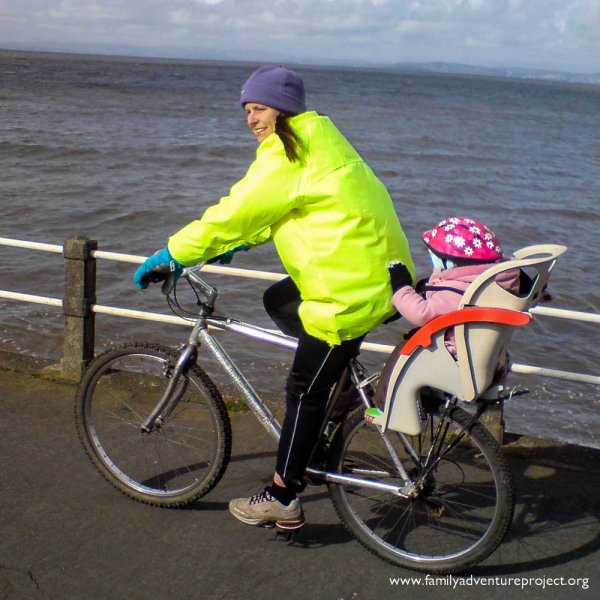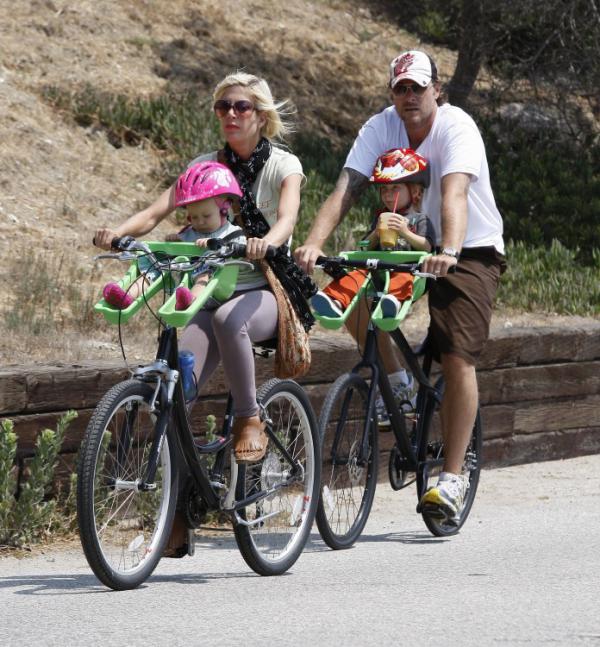Cycling With a Baby
Do You Feel Safe
What Officials Say
Chris Juden, senior technical officer at the CTC, the national cycling organization, who was also on the committee responsible for the European Standard on bicycle child seats (EN14344), sums up cycling with a baby like this:
“It’s not so much a question of age, but of physical development. Infants vary a lot as to the age at which they are able to sit up unaided (as in sitting in the middle of the carpet, playing with toys etc), which is when they are ready to ride in the usual sort of a bicycle child seat. Usually this is about nine months. And the length of your cycling with a baby between stops, should not exceed the length of time they are content to do that.”
Pediatrician Advice
If you are unsure if you should be cycling with a baby yet, ask your pediatrician if your child is ready.
Fear of Falling
Three Options
Rear Mount 
Back or rear-mounted seats are the most widely used bike seats for cycling with a baby. They fit over the back wheel and usually have a high back and raised sides, leg guards, and a harness. Here’s a few characteristics:
- Pro: Babies are well supported if they want to sleep.
- Pro: You can use the seat to carry shopping items when you don’t have your baby on board.
- Con: Carrying extra weight on the back of the bike at this height can make your bike top heavy.
- Con: You can’t see what your child is up to while you’re cycling and your baby can’t see much.
Front-Mount 
Your baby sits in front of you. You place your arms around the seat to steer. Because your arms have to go around the seat and your vision of the road needs to be clear, front-mounted seats are more minimalist than rear-mounted seats.
- Pro: Closer contact with your child and your child is always visible to you.
- Pro: More fun for the baby.
- Con: Can affect the bike’s maneuverability with the weight on the handlebars.
- Con: Although popular in mainland Europe, front-mount seats can be hard to find.
Trailers to Tow 
Trailers behind your bike are often attached to your bike via the rear axle and skewer. The are better as your child grows older as there is less support for a baby.
- Pro: Lower to the ground, safer in a falling accident.
- Pro: Easier to handle, more maneuverable as it doesn’t affect the steering or leaning of the bike.
- Lots of cargo space when carrying or not carrying a baby.
- Con: Difficult to see for motorists.
- Con: Wider, can hook on objects, stick out into traffic.
- Con: Heavier, harder to stop.
The Verdict on Safety
All types of bicycle carriers have safety issues. The American Academy of Pediatric’s position is that it’s preferable for a child to ride in a bicycle trailer rather than a front or rear-mounted bicycle seat. The reasoning: “because a young passenger on an adult’s bike makes the bike unstable and increases braking time.” The AAP says that a mishap at any speed on a bicycle-mounted seat could cause significant injury to a child.
One More Option
The Taga 3 in 1 Baby Stroller Bike 3 Wheel 16” Pushchair Carrier Folding Mother’s Bicycle is yet another option to take a look at. This version of a bike with carrier is genius and should be considered for cycling with a baby.
Tips For Cycling With a Baby
- It’s not recommended taking a baby for a ride who can’t support his or her own head – or until the time he or she can wear a cycling helmet. Your baby should also be able to sit well unaided.
- Wearing a cycle helmet reduces the risk of head and brain injury. You and your child should always wear a helmet when on a bike.
- Check with the bike retailer that your bike is suitable for use with a particular type of child seat or trailer as not all bike designs are suitable with baby seats.
- Make sure your seat has footrests to prevent your child’s feet from becoming caught in the spokes of the wheel.
- Child seats for cycles should carry BSI number BS EN 14344:2004 to comply with required safety standards.
Weight, Safety, and Bike Integrity
Choices and Choices
The type of carrier you choose also depends on where you live. Do you live in a small town? A city with lots of hills? Miles from your daily destinations? Lots of traffic? Having an idea of how far you will ride on a typical day, on what routes, and over what terrain will help you decide on the right bike set-up and route that keeps you safe and out of traffic. Rural roads, country roads, bike paths, and designated bike lanes are all good choices from a safety standpoint. Try to avoid rugged or torn up potholed road surfaces.
